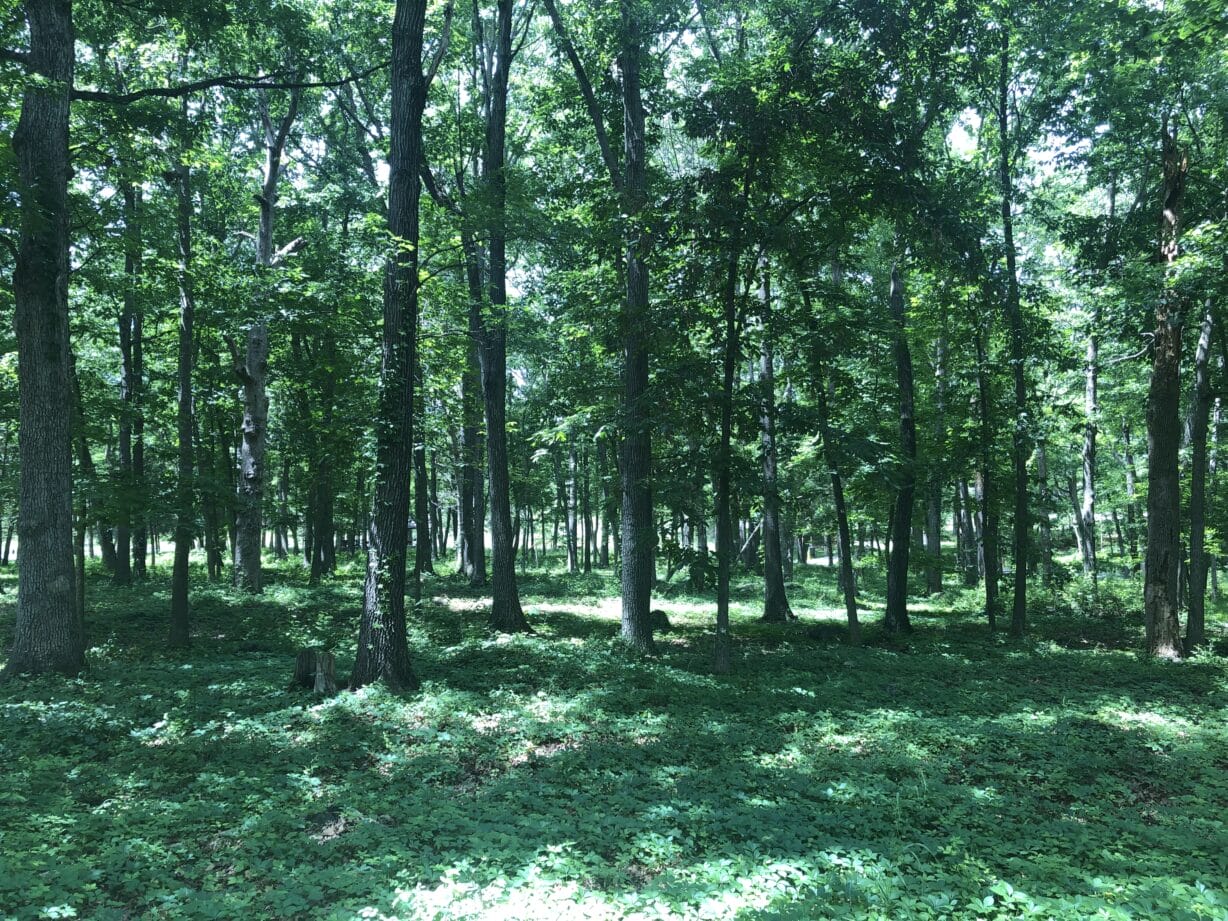
By Sofia Samatar
“The Friendly City” is a weekly column about walking in Harrisonburg that will run during 2024. Each week, your friendly correspondent, writer and teacher Sofia Samatar, will reflect on a walk in our city.
Early in the morning, I walk to green, leafy Hillendale Park. The sky is like gauze, with a pearly brilliance near the sun, promising hot weather; over the trees, it takes on a pale aquamarine color, streaked with white. Couples are out with their dogs, enjoying a stroll before it gets too warm; a jogger bounces firmly over the gravel; an elderly walker passes me, moving with great energy, propelled along by a pair of hiking poles. The park extends in long swaths of terrain like the stripes on a woven rug: meadow to my left, forest to my right, and the creek down the center. The creek is shy here, hidden, identifiable not by its water but by its bridges, which arch over long, tufted grasses. This must be what suggested the image of a carpet to my mind: the transformation of the creek, usually made of water, however shallow, into a rustling, flaxen, threadlike material.
I pass the familiar park structures—playground equipment, wooden pavilions with picnic tables—thinking of the structure of the park itself, its pattern of grass and water and trees, its winding paths, the variety of its plants. Sun warms my left shoulder; my right is in the shade. The park has a dappled structure, as if its planners set out to copy, on a large scale, the irregular grid of light and shadow that speckles the grass under the oaks, fluttering in a soft gust of wind.
Surely this is the most pleasant environment for walking: a shifting patchwork of brightness and dimness, a quilt of light.
Suddenly a deer walks up to the path. A beautiful little doe. She stops. I stop. For a moment we look at one another. She is poised, neat and motionless, in the middle of the way. Then she turns, crossing unhurriedly to the forest side with rhythmic, almost turkey-like movements of her neck, with her reddish flanks and incredibly thin legs, and behind the white and black of her tail. She has passed underneath the trees. She walks through the uneven drizzle of honeyed light that falls through the leaves, her little tail hanging darkly down. I start down the path again, perpendicular to her trail, watching her go, and she turns to look at me. Again she stops. I stop. She’s doesn’t seem startled or afraid, she’s just there, looking at me until she turns again to go, wandering into the shadows, becoming a small blurred ball of brownish stuff that disappears in the deep green of the wood.
I know deer are considered a pest. They ravage gardens and cause traffic accidents. Once, when I was driving my son to soccer practice, a huge buck cantered out right in front of my car on Old Furnace Road, bearing antlers that looked to me, in my panicked state, about the size of my dining-room table. Fortunately, there was no one behind me, because—without even the presence of mind to glance in the mirror—I slammed on the brakes. The buck crossed the road, then turned around and bounded across in the other direction, for all the world as if he owned the place. Deer, I admit, can be a menace. But how strange and marvelous it is when someone steps out of the trees and looks at you—someone of a different species with a pure, unfathomable gaze, like an animated particle of the forest.
And the forest—not a wild forest, of course, but a city forest of a comfortable, homey size—bears a trace of that enchantment. There’s something solemn and magical about entering this shade, walking the trails through the exuberant foliage of the forest floor. The summer growth has completely covered the dead leaves from last year, the whole floor is a leafy expanse lit by golden gleams of sunlight dripping down, and a sweetness fills the air, the rich smell of mold, of the old leaves crumbling into the earth, an intense distillation of decay and life going on under these fallen trunks with their blotched and brindled bark, life and decay beneath this luxuriant growth, privet and garlic mustard and creeper, pointy leaves, lobed leaves, heart-shaped leaves, oblong leaves, round leaves, jagged leaves, smooth leaves.
It’s in the nature of variegated patterns to recede. Solid colors stand out; marbled colors are hazy, indefinite, background. Camouflage fabric is patchy, designed to disappear, like the deer in the wood or the creek in its feathery cloak of weeds. These tiny flowers that stipple the forest floor—dainty yellow wood sorrel, fuzzy clover, smartweed strung with impossibly delicate amethyst beads—they’re like the designs on decorative wallpaper, easy to ignore. It takes an effort even to see them (as well as, in my case, eyeglasses with the correct prescription). Yet how congenial, how restorative such surroundings are, these intricate tapestries that don’t impose themselves on the eye, that don’t seem to call for attention. Mottled patterns are forgettable because they enable a relaxed focus, a drifting consciousness, an expansion of thought. To live in constant light or constant darkness would be a nightmare.
“Glory be to God for dappled things,” Gerard Manley Hopkins says. The trees are thinning out ahead, the green light of the grass beyond growing stronger, and I draw in a few last ambrosial breaths of the cool of the wood, its loamy fragrance, and its subdued, beneficent, dappled atmosphere.
